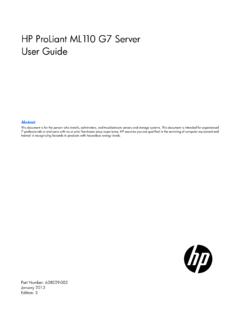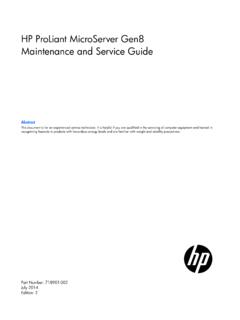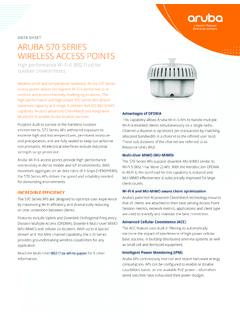Transcription of Aruba 500 Series Wireless Access Points Data Sheet
1 DATA SHEETT hese affordable Wi-Fi 6 Access Points provide high -performance connectivity for any organization experiencing growing numbers of mobile, IoT and mobility requirements. With a maximum aggregate data rate of Gbps ( Gbps), they deliver the speed and reliability needed for venues and workplaces such as schools, midsize offices and retailers. INCREDIBLE EFFICIENCYThe 500 Series APs are also designed to optimize user experience by maximizing Wi-Fi efficiency and dramatically reducing airtime contention between clients. Features include Orthogonal frequency-division multiple Access (OFDMA), bi-directional multi-user MIMO and cellular optimization. With up to 2 spatial streams (2SS) and 80 MHz channel bandwidth (HE80), the 500 Series provides groundbreaking Wireless capabilities for budget-conscious the Multi-User white paper for further of OFDMAThis capability allows Aruba s APs to handle multiple Wi-Fi 6 capable clients on each channel simultaneously, regardless of device or traffic type.
2 Channel utilization is optimized by handling each transaction via smaller sub-carriers or resource units (RUs), which means that clients are sharing a channel and not competing for airtime and bandwidth. Aruba Air Slice for Extended Application AssuranceInitially, APs in controller-less mode (Instant) can provide SLA -grade performance by allocating radio resources, such Aruba 500 Series Wireless Access POINTSCost-effective Wi-Fi 6 ( ) for medium-density indoor environmentsas time, frequency, and spatial streams, to specific traffic types. By combining Aruba s Policy Enforcement Firewall (PEF) and Layer 7 deep packet inspection (DPI) to identify user roles and applications, the APs will dynamically allocate the bandwidth needed. Non-Wi-Fi 6 clients can also Slice for APs uses Aruba Central for management. Controller-based APs will be supported in a future software FEATURES Gbps of maximum throughput WPA3 and Enhanced Open security Built-in technology that resolves sticky client issues for Wi-Fi 6 and Wi-Fi 5 devices OFDMA and MU-MIMO for enhanced multi-user efficiency IoT-ready Bluetooth 5 and Zigbee supportDATA Sheet Aruba 500 Series Wireless Access POINTSM ulti-user MIMO (MU-MIMO)The 500 Series AP supports downlink MU-MIMO just like Wi-Fi 5 ( Wave 2) APs.
3 The added benefit is the ability to multiply the number of clients that can now send traffic, thus optimizing client-to-AP spatial stream 6 and MU-MIMO aware client optimizationAruba s patented AI-powered ClientMatch technology eliminates sticky client issues by placing Wi-Fi 6 capable devices on the best available AP. Session metrics are used to steer mobile devices to the best AP based on available bandwidth, types of applications being used and traffic type even as users roam. Aruba Advanced Cellular Coexistence (ACC)This feature uses built-in filtering to automatically minimize the impact of interference from cellular networks, distributed antenna systems (DAS), and commercial small cell or femtocell Power Monitoring (IPM) Aruba APs continuously monitor and report hardware energy consumption. They can also be configured to enable or disable capabilities based on available PoE power ideal when wired switches have exhausted their power budget.
4 Green AP energy efficiencyAruba Wi-Fi 6 APs utilize analytics from NetInsight to automatically transition in and out of a sleep mode based on client density. Learn more in the Green AP PLATFORM CAPABILITIESLike all Aruba Wi-Fi 6 APs, the 500 Series includes an integrated Bluetooth 5 and radio (for Zigbee support) to simplify deploying and managing IoT-based location services, asset tracking services, security solutions and IoT sensors. This allows organizations to leverage the 500 Series as an IoT platform, which eliminates the need for an overlay infrastructure and additional IT resources. Target Wake Time (TWT)Ideal for IoTs that communicate infrequently, TWT establishes a schedule for when clients need to communicate with an AP. This helps improve client power savings and reduces airtime contention with other SECURE INFRASTRUCTUREThe Aruba 500 Series includes components of Aruba s 360 Secure Fabric to help protect user authentication and Wireless traffic.
5 Select capabilities include:WPA3 and Enhanced OpenSupport for stronger encryption and authentication is provided via the latest version of WPA for enterprise protected Open offers seamless new protection for users connecting to open networks where each session is automatically encrypted to protect user passwords and data on guest networks. WPA 2-MPSK MPSK enables simpler passkey management for WPA2 devices should the Wi-Fi password on one device or device type change, no additional changes are needed for other devices. Requires ClearPass Policy PN TunnelsIn Remote AP (RAP) and IAP-VPN deployments, the Aruba 500 Series can be used to establish a secure SSL/ ipsec vpn tunnel to a Mobility Controller that is acting as a VPN concentrator. Trusted Platform Module (TPM)For enhanced device assurance, all Aruba APs have an installed TPM for secure storage of credentials and keys, and boot AND SECURE ACCESSTo simplify policy enforcement, the Aruba 500 Series uses Aruba s policy enforcement firewall (PEF) feature to encapsulate all traffic from the AP to the Mobility Controller (or Gateway) for end-to-end encryption and inspection.
6 Policies are applied based on user role, device type, applications, and location. This reduces the manual configuration of SSIDs, VLANs and ACLs. PEF also serves as the underlying technology for Aruba Dynamic CONNECTIVITYEach 500 Series AP provides connectivity for a maximum of 256 associated clients per radio (512 in total). In real-world scenarios, the maximum recommended client density is dependent on environmental conditions. DATA Sheet Aruba 500 Series Wireless Access POINTSFLEXIBLE OPERATION AND MANAGEMENTA unique feature of Aruba APs is the ability to operate in either controllerless (Instant) or controller-based mode. Controller-less (Instant) modeIn controllerless mode, one AP serves as a virtual controller for the entire network. Learn more about Instant mode in this technology Controller modeFor optimized network performance, roaming and security, APs tunnel all traffic to a mobility controller for centrally managed traffic forwarding and segmentation, data encryption, and policy enforcement.
7 Learn more in the ArubaOS optionsAvailable management solutions include Aruba Central (cloud-managed) or Aruba AirWave a multi-vendor on -premises management solution. For large installations across multiple sites, APs can be factory-shipped and can be activated with Zero Touch Provisioning through Aruba Central or AirWave. This reduces deployment time, centralizes configuration, and helps manage inventory. ADDITIONAL WI-FI FEATURESEach AP also includes the following standards-based technologies:Transmit beamforming (TxBF)Increased signal reliability and rangePasspoint Wi-Fi (Release 2) (Hotspot )Seamless cellular-to-Wi-Fi carryover for guests Dynamic Frequency Selection (DFS)Optimized use of available RF spectrumMaximum Ratio Combining (MRC)Improved receiver performanceCyclic Delay/Shift Diversity (CDD/CSD)Greater downlink RF performanceSpace-Time Block CodingIncreased range and improved receptionLow-Density Parity Check (LDPC)High-efficiency error correction for increased throughputDATA Sheet Aruba 500 Series Wireless Access POINTSTECHNICAL SPECIFICATIONSM odelAP-504AP-505AP typeIndoor, dual radio, 5 GHz and 2x2 MIMO5 GHz radioTwo spatial stream Single User (SU) MIMO for up to Wireless data rate with individual 2SS HE80 client devices, or with two 1SS HE80 MU-MIMO capable client devices radioTwo spatial stream Single User (SU)
8 MIMO for up to 574 Mbps Wireless data rate with individual 2SS HE40 client devices or with two 1SS HE40 MU-MIMO capable client devices simultaneouslyMaximum number of associated client devicesUp to 256 associated client devices per radio Maximum number of BSSIDs16 BSSIDs per radioSupported frequency bands (country-specific restrictions apply) to to to to to channelsDependent on configured regulatory domainSupported radio technologies : Direct-sequence spread-spectrum (DSSS) : Orthogonal frequency-division multiplexing (OFDM) : Orthogonal frequency-division multiple Access (OFDMA) with up to 8 resource units Supported modulation types: : BPSK, QPSK, CCK : BPSK, QPSK, 16-QAM, 64-QAM, 256-QAM (proprietary extension) : BPSK, QPSK, 16-QAM, 64-QAM, 256-QAM, 1024-QAM (proprietary extension) : BPSK, QPSK, 16-QAM, 64-QAM, 256-QAM, high-throughput (HT) support:HT20 very high throughput (VHT) support:VHT20/40 high efficiency (HE) support:HE20/40/80 Supported data rates (Mbps): : 1, 2, , 11 : 6, 9, 12, 18, 24, 36, 48, 54 : to 300 (MCS0 to MCS15, HT20 to HT40), 400 with 256-QAM : to 867 (MCS0 to MCS9, NSS = 1 to 2, VHT20 to VHT80), 1,083 with 1024-QAM ( ): to 574 (MCS0 to MCS11, NSS = 1 to 2, HE20 to HE40) (5 GHz): to 1,201 (MCS0 to MCS11, NSS = 1 to 2, HE20 to HE80) packet aggregation:A-MPDU, A-MSDUT ransmit power:Configurable in increments of dBmMaximum (aggregate, conducted total) transmit power (limited by local regulatory requirements) GHz band: +21 dBm (18dBm per chain)5 GHz band: +21 dBm (18 dBm per chain)Note: conducted transmit power levels exclude antenna gain.
9 For total (EIRP) transmit power, add antenna Sheet Aruba 500 Series Wireless Access POINTSWI-FI ANTENNASAP-504AP-505 Two (female) RP-SMA connectors for external dual band antennas (A0 and A1, corresponding with radio chains 0 and 1). Worst-case internal loss between radio interface and external antenna connectors (due to diplexing circuitry): in and in integrated dual-band downtilt omni-directional antennas for 2x2 MIMO with peak antenna gain of in and in 5 GHz. Built-in antennas are optimized for horizontal ceiling mounted orientation of the AP. The downtilt angle for maximum gain is roughly 30 degrees. Combining the patterns of each of the antennas of the MIMO radios, the peak gain of the combined, average pattern is in and in INTERFACESM odelAP-504AP-505E0: Ethernet wired network port (RJ-45) Auto-sensing link speed (10/100/1000 BASE-T) and MDI/MDX POE-PD: 48 Vdc (nominal) POE (class 3 or 4) Energy Efficient Ethernet (EEE)DC power interface12 Vdc (nominal, +/- 5%), accepts center-positive circular plug with lengthUSB host interface (Type A connector)Capable of sourcing up to 1A / 5W to an attached deviceBluetooth Low Energy ( ) and Zigbee ( ) radio BLE: up to 7dBm transmit power (class 1) and -93dBm receive sensitivity (1 Mbps) Zigbee: up to 6dBm transmit power and -96dBm receive sensitivity Integrated vertically polarized omnidirectional antenna with roughly 30 degrees downtilt and peak gain of indictors (two multi-color LEDs).
10 For System and Radio statusReset button:Factory reset, LED mode control (normal/off)Serial console interfaceProprietary, micro-B USB physical jackSecurity slotKensington security slotPOWER SOURCES AND POWER CONSUMPTIONM odelAP-504AP-505 Power Sources: The AP supports direct DC power and Power over Ethernet The AP supports direct DC power and Power over Ethernet When both DC and POE power sources are available, DC power takes priority over POE Power sources are sold separately; see the 500 Series Ordering Guide for details When powered by DC or (class 4) POE, the AP will operate without restrictions. When powered by (class 3) POE and with the IPM feature disabled, the AP will disable the USB port. In the same configuration but with IPM enabled, the AP will start up in unrestricted mode, but may dynamically apply restrictions depending on the POE budget and actual power. The feature restrictions and order can be (worst-case) power consumption (without / with a USB device attached): DC powered: / POE powered ( ): / POE powered ( ): / This assumes that up to 5W is supplied to the attached USB (worst-case) power consumption in idle (DC) or (POE).

















